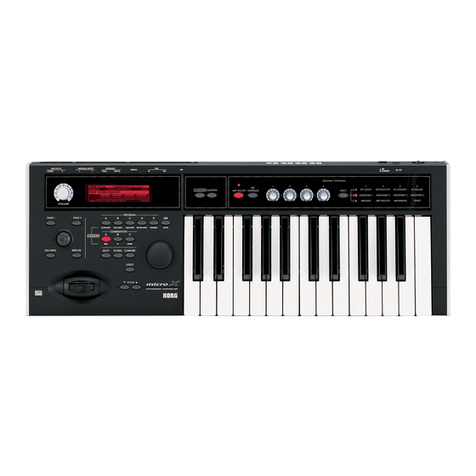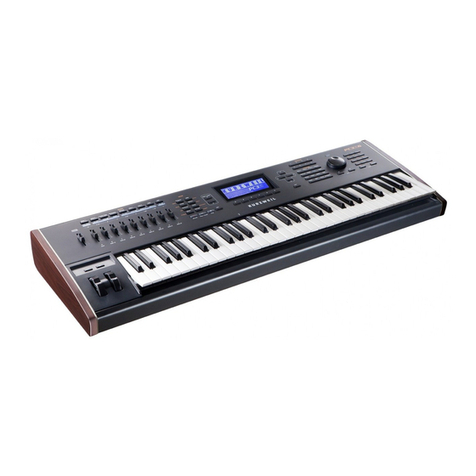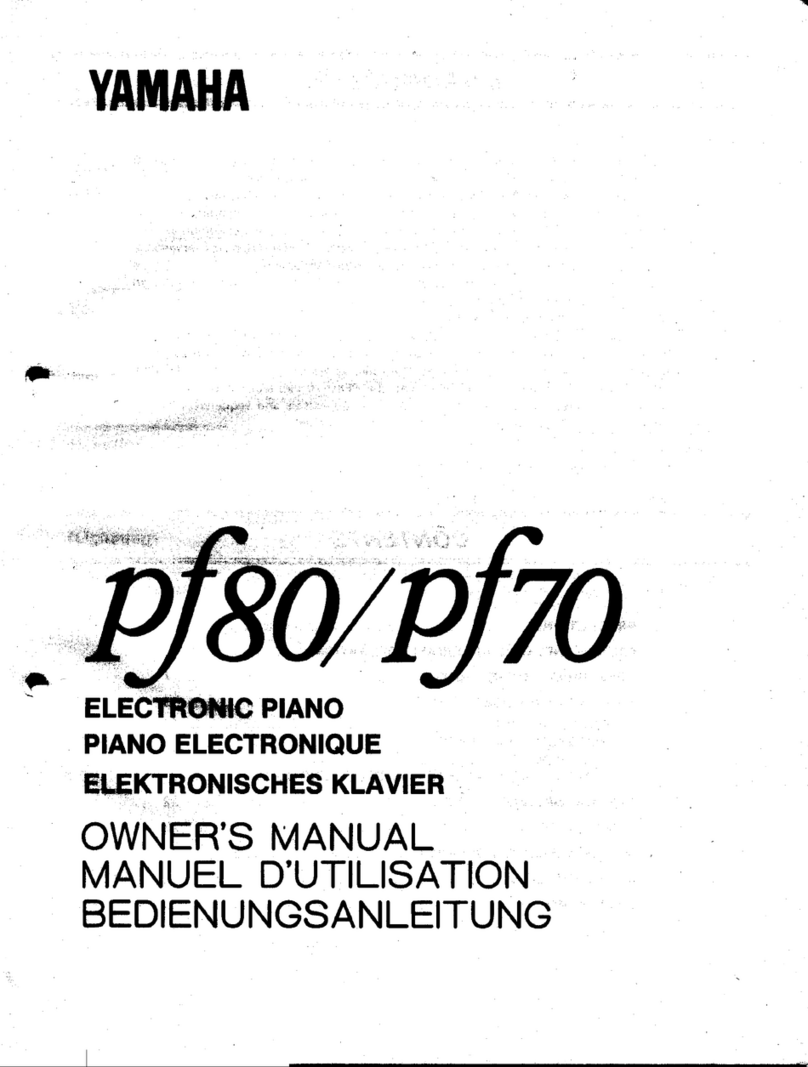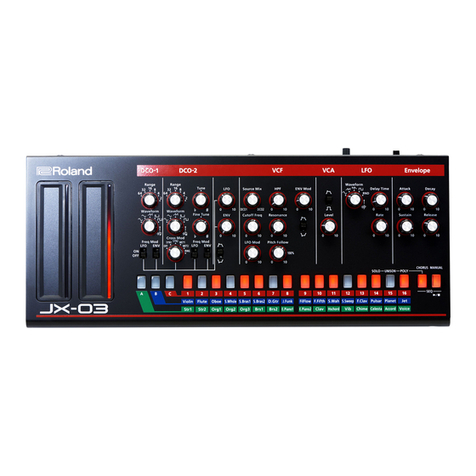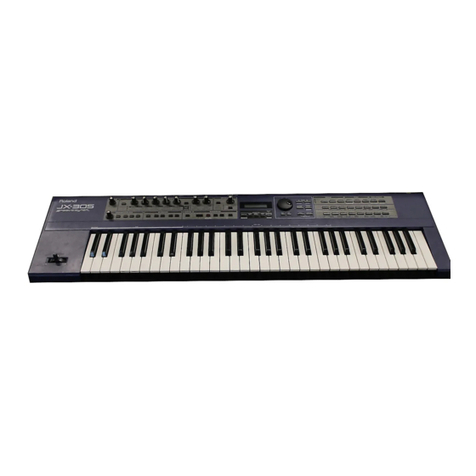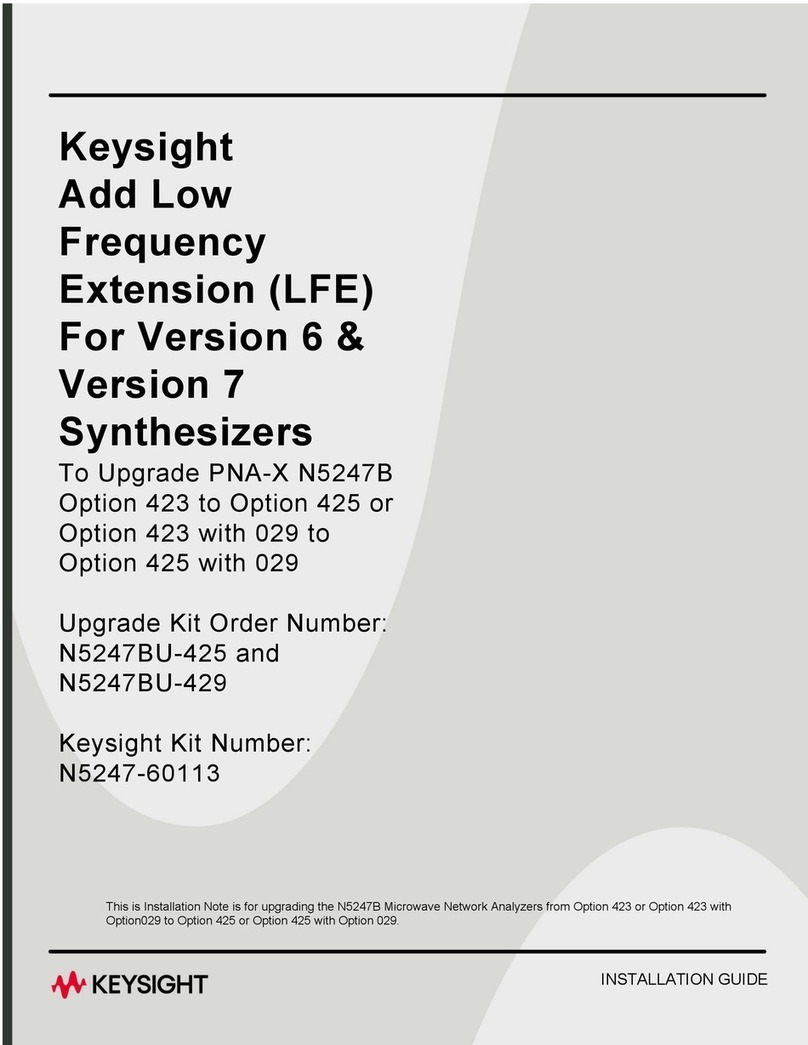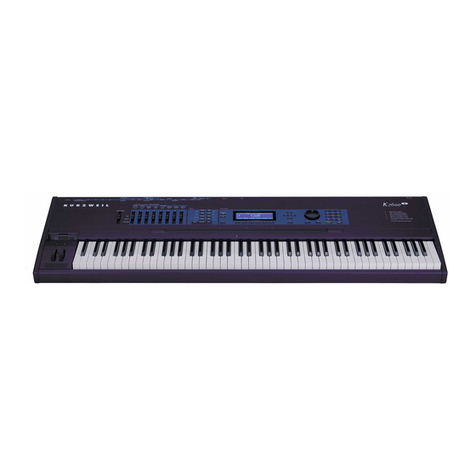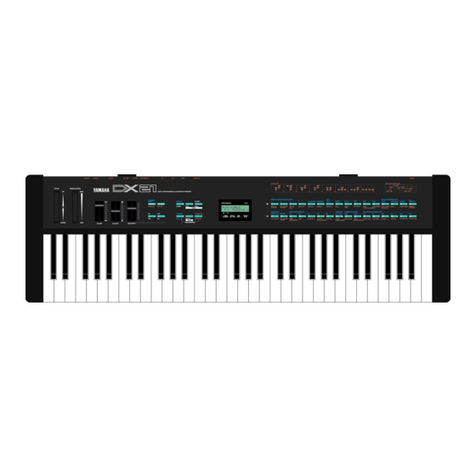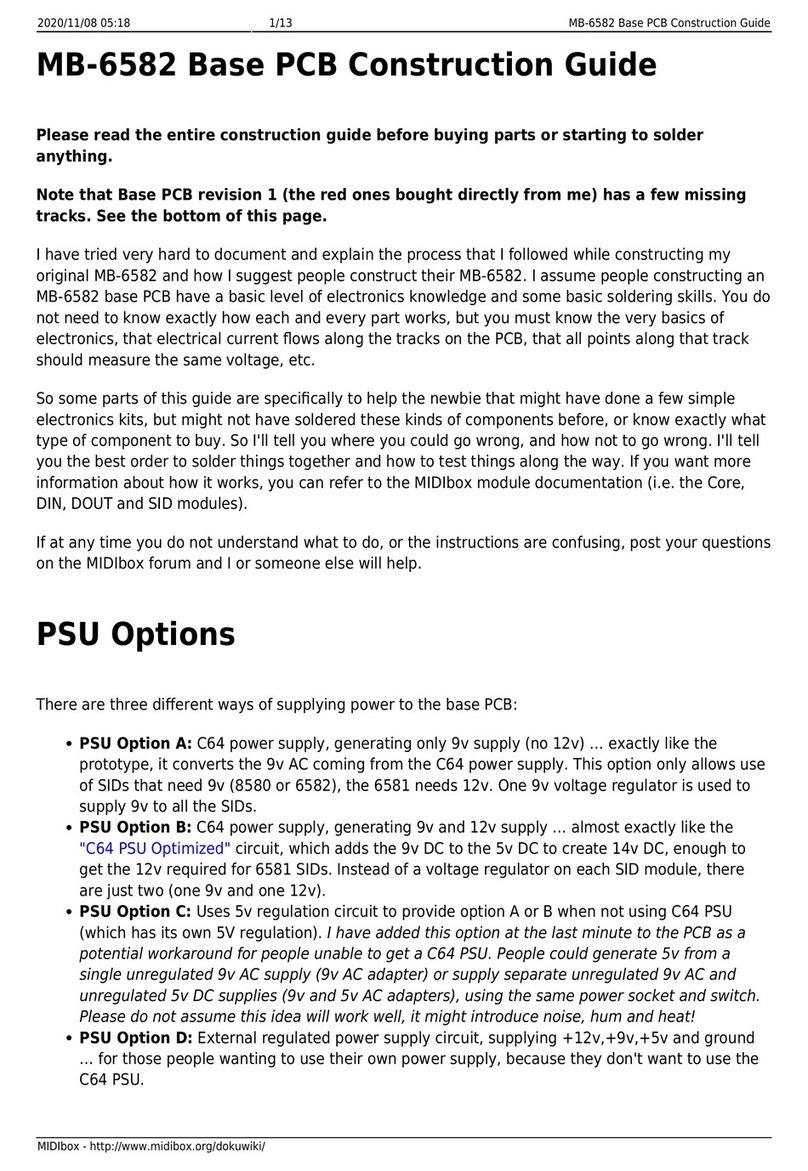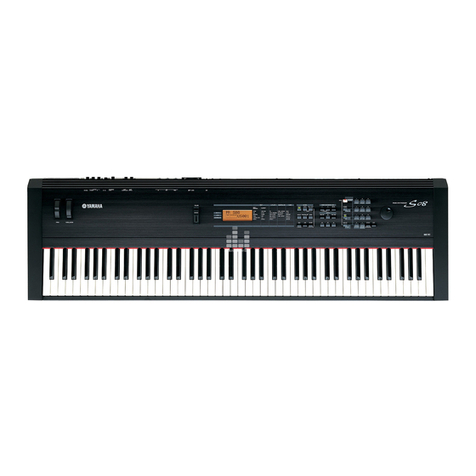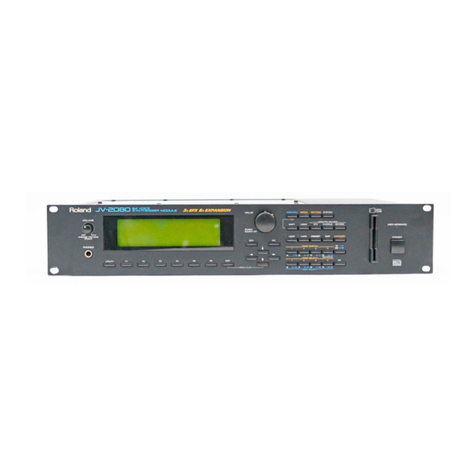SoundToys Crystallizer User manual


2
CONTENTS
CONTENTS 2
THANKS! 4
INTRO 5
About Crystallizer 5
What and Who is SoundToys? 6
GETTING STARTED 7
System Requirements 7
Installing Crystallizer 7
Registration 8
Some Information on Pitch Shifting and Other Stuff… 9
USING CRYSTALLIZER 10
Basics 10
Knobs 10
Toggle Switches 11
LED Displays 11
Accessing Crystallizer 12
Real-Time Processing (RTAS or HTDM) 12
Non-Real Time Processing (AudioSuite) 13
Using Crystallizer Within Pro Tools 14
The Crystallizer Preset Library 14
Compare Button 15
Bypass 15
Using Parameter Automation 15
Locking Crystallizer to Tempo and Down Beat 17
Using the HTDM Version of Crystallizer 19
Optimizing CPU Usage 20
The Crystallizer Control Panel 21
Input and Output Level 21
Mix 21
Pitch 22
Splice 22
Delay 23
Recycle 23
Threshold 23
Gate/Duck 24
Forward/Reverse 25
MIDI Sync 25
Tweak Button 25
FB Mode 25

3
CONTENTS(continued)
Pitch Offset 26
Splice Offset 26
Delay Offset 26
Attack 27
Release 27
Low Cut 27
High Cut 28
Summary 29
FINAL PAGE 30
Getting Help 30
The UltraFX Product Line 31
The UltraTools Product Line 32
Trademark Info 32

4
THANKS!
First off we’d like to give you a loud THANK YOU for purchasing Crystallizer!
We know there are an awful lot of plug-ins for you to choose from and we are truly
grateful that you have chosen to spend your hard earned scratch (old school for cash)
on our product. We take a lot of pride in our work and we sincerely hope that you find
Crystallizer inspirational and musically useful.
We’d also like to thank all the people that helped in the development of Crystallizer
and the whole new SoundToys line of plug-ins:
Nick Caiano for his super-cool demo sessions and guitar work.
Mikail Graham for letting us hi-jack his wonderful collection of guitar pedals (we’ll
return them soon we promise!) and for all the help and feedback along the way.
Wendy Letven for her amazing design work on the SoundToys logo, all the SoundToys
packaging, and much more.
Andrew Schlesinger for all of his help from the very start of the SoundToys concept
from product names, design ideas, and presets, to his witty and useful contributions
to this user guide and other sage advice.
Our whole crew of beta testers for Crystallizer, especially Arthur Alexander, BT,
Jez Colin, Andy Gray, Fab, Lars Fox, Terry Fryer, Peter Freeman, Jon Goldstein, Rich
Hilton, Michael James, Pete McCabe, Oliver Momm, Allan Speers, Morgan Page,
Michael Costa, Andrew Souter, Willie Wilcox, Doc Wiley, and Richard Zvonar.
––– Ken, Bob, Jamey, Noah, Mitch and Aimee

5
INTRO (the one that comes before the sequel!)
About Crystallizer
Crystallizer is the third in a series of totally cool new plug-ins to come out of the
SoundToys (formerly Wave Mechanics) plug-in development lab. As with FilterFreak,
our Analog Filtering module and PhaseMistress, our killer analog phase shifter, a truly
ridiculous amount of programming time, head scratching, listening and tweaking has
gone into the development and design of Crystallizer in order to provide you with an
incredibly creative, powerful, new granular-pitch-splice-forward-backward-echo-plus-
space-drive-shimmer-accumulator-effect-device for your Pro Tools rig. That makes
sense, right? However, one of the most difficult things facing us is how to describe
what Crystallizer does. It is a special tool and sounds unlike anything else so a little
history may be in order.
A bunch of years ago the brains at our company (Sound Toys in case you did not
know) worked for a little company called Eventide in the swamps of New Jersey (yes,
there are swamps). While there, these geniuses created the H-3000 Harmonizer®
which also contained a new algorithm called Reverse Shift. That algorithm sat around
kind of unused for a little while until this sound designer by the name of Andrew
Schlesinger (yours truly) realized that by using the algorithm with a lot of feedback
and delay that you could create these incredible "Crystal-Like" echoes and shimmer-
ing effects that sounded absolutely incredible, especially on guitar. So a preset was
created called "Crystal Echoes" which has subsequently been used by hundreds of
artists and producers on tons of albums.
Fast-forward to 2004 and you now have an updated and more powerful Pro Tools
plug-in device created by the same guys and based around the same concept (but
with a lot more capabilities). And what does it do? Crystallizer basically grabs a
"slice" of stereo or mono audio coming in from it’s input and plays it back either for-
ward or in reverse with the ability to shift the pitch of the audio slice (4) octaves up,
or (4) octaves down. It also includes the ability to delay the playback of the audio by
up to (2) seconds and most importantly use regeneration or "Recycle" to feed the
output back into the input allowing you to create some radical and beautiful effects
on all sorts of input signals. We have also thrown in our standard fare of "Tweak"
parameters to further mutate the signal, but that will be covered a bit later on.
Since Crystallizer is not your standard fare it is a little hard to accurately describe all
the functions (some are clearer than others) and this is one of those devices that
begs to be tweaked and futzed with. There is nothing to break, nothing to ruin and it
won’t stain your carpet so you might as well just start digging in and playing around
to see what this puppy can do.

6
As with all SoundToys devices we have included a whole bunch of really cool presets
(at least we think so) that span the gamut from relatively tame to "out there". So for
sure take a little time to go through them with different kinds of input material as it
just might create the spark for your next hit
record…CD…MP3…DVD…Film…Game…MUSIC! Right!
What and Who is SoundToys Anyway?
If you already own one of our other products like FilterFreak or PhaseMistress you
can skip this section but if not, read on to find out who we are and what we do!
So what the heck is "SoundToys" anyway? SoundToys is a concept, a vision, a new
line of totally cool, sonically superior audio FX plug-in devices designed to set a new
standard in regards to plug-in processing and sound. And, it’s our new company
name.
You see all of us at SoundToys (formerly Wave Mechanics) are a bunch of audio geeks
that thirst for new ways to manipulate and mangle sound that are innovative, unique,
and with sound quality that is in a class all its own.
While everyone and their grandmother is modeling older gear these days, we are
busy wracking our collective brains to develop NEW devices that are truly inventive
and will stand the test of time – the kind of things you’d take with you to a desert
island.
Just so you know, we are the guys that were responsible for designing such ground-
breaking and industry standard products as the Eventide H-3000, DSP-4000, and
the Wave Mechanics UltraTools line of plug-ins for Pro Tools TDM. Our DSP algo-
rithms can even be found in such high-end studio gear as the TC Electronics
Fireworx, G-Force, and G-Major processors, and more.
Our approach in developing the SoundToys series of Pro Tools plug-ins is to create a
series of dedicated processors that provide the absolute best possible sound quality,
flexibility and creative sound manipulation in the wonderful world of digital, but that
also possess that truly analog character and vibe.

7
GETTING STARTED
System Requirements
Crystallizer is a software plug-in for the Digidesign Pro Tools system. You’ll need to
have at least one decent Macintosh computer (G3 or better – faster is always better)
running OS 9.2 or later and of course you’ll need a copy of Pro Tools version 5.0 or
later. To use Crystallizer you’ll also need one of those little "iLok" hardware keys.
It’s a small blue plastic key that looks like this:
If you don’t have an iLok we’ll be
happy to sell you one at a modest
price or you can purchase one
from Digidesign or your favorite
Pro Tools dealer.
Installing Crystallizer
Installing Crystallizer is really pretty easy. First, make sure that you have your iLok
hardware key connected to your computer, and that you have the Crystallizer license
card handy. Once you’re ready, simply pop the Crystallizer CD into your computer’s
CD-ROM drive and when the CD icon appears on your screen double-click the
Crystallizer installer program to start the process.
Follow any instructions included in the installer and at the end of the installation
process you will be prompted to ‘authorize’ Crystallizer. To do this, carefully detach
the license chip from the license card, and insert the chip into the slot in the rear of
your iLok.
Once installed, a copy of the Crystallizer plug-in will be located in your Digidesign
plug-ins folder along with a cool set of Crystallizer presets. Finally, a SoundToys fold-
er will be created in your Applications folder. Please note that if you already have
FilterFreak, our totally cool analog filter box, this folder will already be on your hard
drive and Crystallizer will be placed there. The SoundToys folder contains this manu-
al, as well as other useful documentation and tools that you can read or ignore
depending on your level of patience or interest in reading babbling things like this
manual.

8
Registration
If you chose not to register your product during the Crystallizer installation, please
take a moment to register Crystallizer by going to http://www.soundtoys.com/register.
We also strongly recommend that you go to http://www.iLok.com, set up an iLok.com
account, and register your Crystallizer authorization.
So, why should you bother with all this tedious registration stuff? When the day comes
that your pet boa constrictor swallows your iLok in the middle of a recording session,
and you NEED to use Crystallizer, we will be able to get you up and running again
MUCH MORE QUICKLY. If you haven’t taken the time to do this, we will still try to help
you, but we’ll have no easy way of knowing whether you are really you, or some bozo
that swiped your copy of Crystallizer when you weren’t looking.

9
Some Information on Pitch Shifting and Other Stuff…
As we mentioned earlier, it is a bit hard to describe how this thing really works but a
little more detail might be helpful as there are "oddities" involved in pitch shifting
and reverse shifting that are worth noting. Nothing bad, just inherent aspects of the
process that are worth a few words of explanation.
As we stated earlier, a pitch shifter grabs a slice of audio and plays it back at a dif-
ferent speed to create the alteration in pitch. The important thing to know is that in
reality the pitched signal is really being "pushed up" or "pushed down" and modulat-
ed with a kind of saw tooth wave and the farther you move from the original frequen-
cy the faster this modulation occurs. This is sometimes referred to as "glitching" and
is an artifact and byproduct of all pitch shifting algorithms.
It is not just how
far
you deviate from the original pitch (shifting up as opposed to
down usually introduces more artifacts) but how
big a slice
of the audio you set the
unit to sample that also has some affect on both the speed and depth of the modula-
tion. In addition, the larger the slice the more inherent delay is introduced between
the time the original signal is played and the slice of audio that is played back.
As the
size of the slice increases
so does the
amount of delay
between the original
signal and the playback of the effected signal. But this delay time does not remain
constant due to the modulation that is used in creating the pitch shift. So if you use
a long slice and play a riff, the time between your playing the original riff and the
playback for the effected riff can vary due to the modulation of the effected signal.
Most pitch shifters automatically adjust the size of the slice to keep it constant so
that the effected signal is played back with just a little bit of delay. Crystallizer, on
the other hand, offers you the ability to take
much larger
slices of audio, shift the
signal up or down (4) octaves (that’s a lot of shifting!), play the pitch shifted signal
back either in forward or reverse and allows you to feed the output of the shifted sig-
nal back into the input so as the signal repeats it is re-shifted with each successive
repeat. It also provides the ability to tempo lock the playback so that the repeating
signal always starts playing back on the selected beat.
So the important things to keep in mind are the fact that the pitched signal is con-
stantly being modulated, and the larger the slice of audio the longer the inherent
delay between the original sounds and the effected signal, and finally, that this delay
is not always constant.

10
USING CRYSTALLIZER
Basics
Note: Since you would probably not be reading this unless you own a Pro Tools sys-
tem we kind of take it for granted that you have at LEAST a basic working knowledge
of your computer and of Pro Tools. If you don’t, we strongly suggest you make your-
self a strong cup of coffee (or two), get a comfortable chair and familiarize yourself
with the ins and outs of your Pro Tools system before delving too much further into
Crystallizer. Digidesign is really nice and provides lots of manuals for your reading
pleasure!
Knobs
You can use a mouse to control all of the knobs in Crystallizer and they all work in
the same way: To turn a knob up, (to the right, clockwise etc), click on the knob with
your mouse and drag the cursor to the right or slide the cursor up (towards the ceil-
ing). To turn a knob down, (to the left, counter-clockwise), click on the knob with the
mouse and drag the cursor to the left or down (towards the floor). "Mousing" around
in a circle doesn’t really work; you’ll just get frustrated and or dizzy, neither of which
is a lot of fun.
Jumping to a Value using Text Markings
Some knobs have text markings showing minimum, maximum, or other values.
Clicking on one of these text markings will automatically move the knob directly to
that value.
Returning a Knob to its Default Value
To return to the knobs "default value", simply hold down the
option
key and click on
the knob. This will automatically move the knob back to its default value.
Viewing a Knob’s Exact Value
To view the exact numerical value of a knob simply hold down the
control
key and
click on the knob. To see the knob’s title, hold down
control
and click on the knob a
second time.
Adjusting a Knob with Fine Control
To get finer control over knob values, hold down the apple ðkey while dragging the
mouse.

11
Toggle Switches
In an effort to provide the feeling of real analog gear our toggle switches "switch"
when clicked. To change the "state" of a toggle switch (like the analog/digital
control), simply click on the switch. It will change from where it was to the "other"
setting. Click again to change it back. Really simple!
LED Displays
LED displays on Crystallizer work in a couple of ways:
Nudge Buttons
Most text readouts also include a pair of nudge buttons next to the display. Clicking
on the upper button will increase the value by one and clicking once on lower button
will decrease the value by one. This is useful for tweaking a value by small steps.
Numerical Readouts & Entering Values from the Keyboard
For numerical readouts, (like BPM), you can enter exact values right from your com-
puter keyboard. Clicking on the LED display highlights the field and makes it "live".
Once highlighted, you can enter a new value via the computer keyboard. Press,
"Return" to submit the value and deselect the field. You can also click & drag the
cursor to change the value. Simply click on the value and drag the cursor up to
increase the value or down to decrease the value, similar to using a knob control.
Press, "Return" to submit the new value and deselect the field.

Pop-Up Menus & Changing Values:
For most text-based readouts (meaning things that aren’t a number), like LFO
WaveShape etc, clicking on the readout with the mouse will display a pop-up menu.
To change a value in the pop-up, hold down the mouse button and drag to select the
desired value and let go. The selected entry will show up in the field, or a new pop-up
window may appear depending on what you have selected.
Accessing Crystallizer
Now that you know how to use knobs and pop-up menus, it’s time to actually use
Crystallizer within Pro Tools. Crystallizer is available to process your audio in two
different ways: Real-Time, or Non Real-time.
Real Time Processing (RTAS or HTDM)
As a real-time plug-in, Crystallizer works a lot like a real hardware…umm…
Crystallizer! Whatever sound goes into Crystallizer, comes out filtered, and you can
hear it as it is happening (in real time!). Keep in mind that using Crystallizer in this
manner always chews up some CPU processing power.
To use Crystallizer in this way, you must first select Crystallizer as one of the insert
devices within Pro Tools, by clicking on the inserts button on a track. You can do this
either from the edit or mix window in Pro Tools. From the inserts pop-up, select
Crystallizer as shown in the next graphic...
You can insert as many versions of Crystallizer as you’d like. Just keep in mind that
each one gobbles up a certain amount of CPU cycles and can make your computer
start to sweat in terms of what’s left over for other tasks.
12

13
Non-Real Time Processing (AudioSuite)
If you want to save computer power, Crystallizer can also be used to process a specif-
ic region of audio destructively. This is done in Pro Tools using the AudioSuite version
of Crystallizer. To do this, first select the region of audio you’d like to process from the
Edit window of Pro Tools. Then choose Crystallizer from the AudioSuite menu of Pro
Tools.
Hit the process button to process the selected region with Crystallizer and to write
the result back to disk. To hear the effect before committing to disk, click on the
preview button.

14
Compare Button
Automation Button
Preset Librarian Bypass
Using Crystallizer Within Pro Tools
Crystallizer is designed to be very integrated with Pro Tools, supporting all of the
"standard” Pro Tools plug-in features and controls including parameter automation,
MIDI control, etc. Access to these functions can be found in the gray bar that Pro
Tools attaches to the top of Crystallizer. The display below shows the real-time
version of Crystallizer. When using the AudioSuite version, an additional gray bar will
appear on the bottom with buttons to control previewing and processing.
The Crystallizer Preset Library
For your immediate listening pleasure and for those who just can’t wait, we’ve includ-
ed a bunch of carefully crafted, creative, cool presets with Crystallizer. You might
want to check these out, as they not only provide a good example of the various
types of effects that can be achieved with Crystallizer, but one of them just might be
the ticket you need for your latest hit record or production. They also provide a
great starting point for you to tweak and mangle to your hearts content. Besides, we
spent a whole bunch of time making them so you might as well give them a spin.
Loading a Preset:
To view and load a Crystallizer preset, simply click on the Settings Librarian button
located in the standard Pro Tools plug-in controls area, located at the top of the
plug-in window, located in Pro Tools, located on your computer, located in your, oops,

sorry! And as you would expect, for more info on the Pro Tools Settings Librarian,
please read the Pro Tools manual.
Saving a Preset
Saving a preset is just as simple. Click on the small button to the left of the preset
name and choose "Save” to update the current preset, or "Save As” to create a new
preset.
Compare Button
The compare button (often called the compare "light” by Pro Tools pros) is a great way
to audition the effect of any changes you’ve made to one of the Crystallizer presets.
As soon as you change any parameter in Crystallizer, the compare light will come on.
Click on the compare light to toggle between the original preset and your current
changes.
Bypass
One of the more useful features on any plug-in is the Bypass button. Click on this to
bypass the effect of Crystallizer. This also recovers any CPU cycles being used by
Crystallizer.
Using Parameter Automation
Many of the controls in Crystallizer can be automated. Click on the ‘auto’ button to
bring up the Plug-In Automation window. At the left is a list of parameters available for
automation. On the right are any of the parameters that are currently automated.
Select whichever parameter or parameters you’d like to automate then click on the
‘Add’ button. Those parameters will appear on the right side of the window, and can
now be automated from within Pro Tools.
15

16
To record automation data, you’ll first need to do a few things within Pro Tools.
First, bring up the Pro Tools automation window (see Pro Tools Manual for enabling
automation) and make sure ‘plug-in’ is enabled.
Next, in the track you’re working on, select ‘auto-write’ to enable
the real-time recording of automation data.
Now, press play and fiddle with the Crystallizer controls. Pro Tools should now record
any control changes you make. When the transport is stopped, the automation will
automatically switch to ‘auto-touch’.
Please Note: In auto-touch mode, the automation data you’ve just recorded will be
played back, and any new control changes you make will be written over the older
automation data. To prevent these new control changes from being recorded, change
the automation mode to ‘read’. To turn off all automation on this track, set the mode
to ‘off’.
It would be really cool to edit these control changes, wouldn’t it? Pro Tools has got
you covered. From the edit window, click on the waveform button and slide the
mouse over until you see Crystallizer and its automated parameters. Choose
whichever parameter you’d like to edit (it would be nice to see all parameters at
once, but for now you’ve got to work on one at a time.)

17
Now you’ll see the automation control superimposed on the audio waveform. From
this you can click and drag to your hearts content, creating all sorts of wild and
crazy effects!
Locking Crystallizer to Tempo and Down Beat
One of the coolest features of Crystallizer is its ability to synchronize its sweep to
the tempo (BPM) and downbeat (the ‘1’ of 1, 2, 3, and 4) in your music. This is a total-
ly awesome way to make Crystallizer hip-hop and groove along with your tunes.

18
How to Get Crystallizer to Sync
Crystallizer uses MIDI clock to synchronize with your music.
To sync Crystallizer to your tune:
If you are using Pro Tools 6.2 or later simply click on the
‘Midi’ switch on the front panel of Crystallizer. If you are
using an earlier version of Pro Tools, you’ll also need to do
the following:
1. Select ‘MIDI Beat Clock’ from the Pro Tools MIDI menu.
2. From the dialog box, make sure “enable MIDI Beat Clock”
is checked and that Crystallizer (and any other SoundToys
plug-in) are also checked. You will need to repeat this step
every time you insert a new Crystallizer plug-in.
3. Select ‘OK’ to lock to the Pro Tools tempo and
beat clock.
But WAIT! There are still a few things to note
before this will all work. New Pro Tools sessions
always set the default tempo to 120 BPM, and the
downbeat will start at the beginning of the session.
In order for tempo locking to be useful, the down-
beats and tempo of your music needs to line up
with the downbeats and tempo in your Pro Tools
session. If you’ve recorded everything to a click
track within Pro Tools, everything should be cool.
If not, you’ll need to enable the conductor track
within ProTools and create a tempo map for your
song.
Creating a Tempo Map
1. Enable the conductor track by clicking on the conductor button in the transport
window of Pro Tools. If you don’t see the conductor button on the transport win-
dow, Select Display->Transport Window Shows from the Pro Tools menu. Make sure
MIDI and "Expanded" are both checked.
2. Create a tempo map by defining bar | beat markers in your song. A simple way to
do this is to select the first measure of your song (very precisely) in the Edit win-
dow, and then use the Identify Beat command in ProTools (ð- I) to define the
Page 18, 1st pa
Tools" in 3 plac
- Page 18, 1st p
MIDI Beat Cloc
- Page 18, 2nd
Page 18 Under
item 2 should re
‘enable MIDI Be

starting and ending beat numbers for the selection. Pro Tools will then calculate
the correct tempo based on this. If the tempo of your music varies (which it prob-
ably does if it wasn’t recorded to a click), then you may need to repeat this proce-
dure at various points in your song to keep the beat locations lined up correctly.
Hint: It is very, very useful to use a drum track along with the tab to transient
feature within Pro Tools to help with this. If you’re a Pro Tools TDM user, you may
also want to learn about Beat Detective, which can help to automate this potentially
tedious process.
19
More Info: All of this and more are covered in great detail in the Pro Tools manual.
For info about tempo maps and conductor tracks look at Chapter 21 of the Pro Tools
6 reference guide. For info about Beat Detective see Chapter 22, and for info about
the extremely useful tab to transients feature read Chapter 16, Playing and
Selecting Audio.
Using the HTDM version of Crystallizer
If you are a Pro Tools TDM user, Crystallizer is also available as an HTDM plug-in, and
will appear in the TDM inserts menu of Pro Tools. The HTDM version is available
because RTAS plug-ins cannot be used on aux tracks and cannot have real-time
monitoring when used within Pro Tools TDM systems.
The HTDM format allows native plug-ins like Crystallizer to be used just like TDM
plug-ins (except that the host CPU is used for processing instead of the DSP chips on
the DSP farm cards). One very big caveat here is that the HTDM format causes
significant latency (or delay) in the audio stream.

Optimizing CPU Usage
Crystallizer is a native plug-in, which means that it uses your computer’s processor
to do its audio processing. Because of its advanced DSP algorithms, Crystallizer can
put a pretty heavy load on your processor. Here are some tips to reduce the
processing:
• If you’re running multiple tracks through the same effect, use Crystallizer on an
aux track and use sends to route the audio through Crystallizer.
• Commit your effect to disk by using AudioSuite, or, by bouncing to disk
20
IMPORTANT: Digidesign has a special low-latency version of the ‘Stream Manager’
driver for Pro Tools. This can reduce the latency from 1024 audio samples to 256
audio samples (from 21 milliseconds to 5 milliseconds at 48 kHz sample rate!) For
the latest and greatest info on optimizing HTDM for your system and to download
the low latency Stream Manager, please visit the HTDM Q&A page on the Digidesign
website. The link to it is:
http://www.digidesign.com/support/faq/htdm.html
Table of contents
